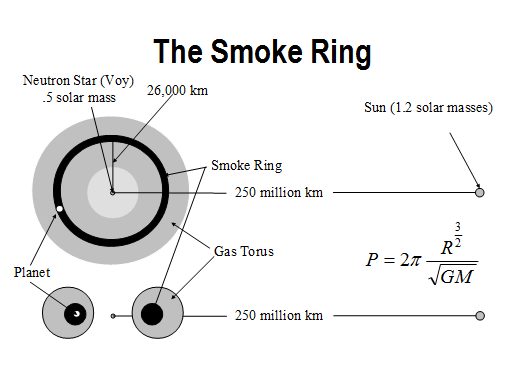
NOTES:
Here's a big object: The Smoke Ring. It is a torus of gas circling an old neutron star, created from the atmosphere of the planet within the Ring. Its radius is about 26,000 kilometers and it gets light from the star that both it and the neutron star circle. It holds life. By the way, there is a real life example of such a gas torus; it exists around Saturn due to interaction between radiation from Saturn and the surface of its moon Enceladus (see Niven's N-Space for details on how he was inspired to create the Smoke Ring).
Being so close to the high gravity of the neutron star, things in the Smoke Ring orbit the star pretty quickly. Niven gives a minimum period of 2 hours, while I get a typical period of a little less than 2 minutes (using this equation). I don't know what causes the discrepancy, unless it's a mistake on the author's part (this is the mistake I mentioned e-mailing Mr. Niven about). The mass of Voy is implied to be 0.5 solar mass which is about 1033 grams, but to get the right answer, the actual mass of Voy would have to be much less (about 1/10000th of a solar mass), which is a pretty implausible value for the mass of a neutron star mass.
The first time I gave this talk a student asked how a planet could have survived the supernova that created Voy - it's in the book that the planet came later and also that Voy is old enough that it is not rotating anymore and therefore not sweeping a radiation beam through the Smoke Ring periodically. Good questions though.
